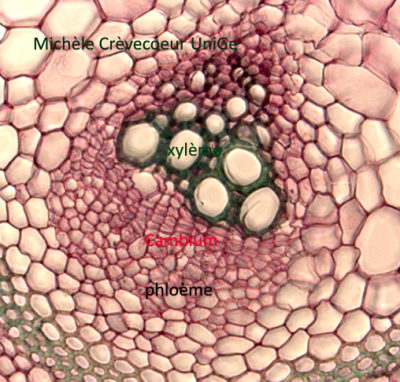Secondary meristems
Growth of animals and humans is determinate: they grow to a specific body size and shape and then stop growing. On the contrary plant growth is indeterminate and takes place throughout their life cycle that can be highly variable according to the plant type. Primary growth makes the stem and roots taller. Secondary growth of roots and stems is characterized by an increase in thickness or girth of the plant and occurs due to activity of secondary meristems: cambium (vascular cambium) and phellogen (cork cambium) that are lateral meristems consisting of flattened, undifferentiated cells. Not all plants exhibit secondary growth. Flowers, leaves and fruits which have a definite growth do not have secondary growth.
(1) Vascular Cambium: it is located between primary xylem and primary phloem and initially differentiates from procambial cells within the vascular bundles. between primary xylem and phloem. At each division an initial keeps the potential of the mother cell to divide and the other cell becomes a cell of xylem or phloem. Divisions are periclinal whatmeans parallel to surface of the organ. It produces secondary xylem toward inside and secondary phloem toward outside, and generally produces more xylem than phloem. As new layers of vascular tissues are added cambium will move far from the center of the organ. The activity of cambium is highly variable: discrete in herbaceous plants, important in woody plants, trees, and shrubs. According to the plant the cambium appears more or less early. (See microphotographs below).
Some cellular characteristics of cambium are common to those of a primary meristematic cell whereas other are different. Common characteristics: thin cellulosic wall, dense cytoplasm rich in ribosomes and endoplasmic reticulum; undifferentiated plastids and small vacuoles. Differences: large vacuoles and no isodiametric form of cells.
In a cross-section cambium appears as layers of flattened rectangular cells (see photograph below).


2/ Phellogen
As result of new secondary vascular tissues in stems and roots there is an increase of organ diameter in the center of the organ and a pressure on epidermis at the periphery, a tissue that will not grow more. Epidermis will progressively disappear to be replaced by a secondary protection tissue the periderm by activity of a secondary meristem, the phellogen also called cork cambium. This functions later than cambium and as cambium this lateral meristem show periclinal divisions into two directions, outside and inside. Phellogen can arise near the epidermis or deeper in the cortex. Less frequently it will develop from phloem cells. This secondary meristem divides to form phelloderm to its inner side and phellem or cork to the outer side. Phelloderm consists in a live tissue with thin cellulosic walls. Walls of cork cells become thicker and become impermeable as result of deposit of a fatty substance called suberin. At maturity cork cells are dead. They are pushed toward outside by formation of new cell layers as result of repetitive divisions of phellogen. The different secondary tissues phellogen, phelloderm and cork form the secondary protective tissue called periderm.
The tissues of phelogen, phelloderm and cork form the periderm, secondary protection tissues.